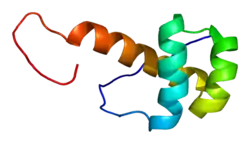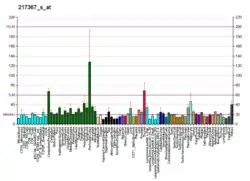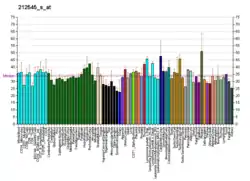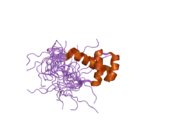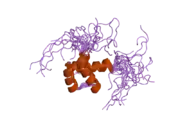ZHX3
Zinc fingers and homeoboxes protein 3 is a protein that in humans is encoded by the ZHX3 gene.[5][6]
This gene encodes a member of the zinc fingers and homeoboxes (ZHX) gene family. The encoded Protein contains two C2H2-type zinc fingers and five Homeodomains and forms a Dimer with itself or with Zinc fingers and homeoboxes family member 1. In the Nucleus, the dimerized protein interacts with the A subunit of the ubiquitous transcription factor nuclear factor-Y and may function as a transcriptional repressor.[6]fx
References
- GRCh38: Ensembl release 89: ENSG00000174306 - Ensembl, May 2017
- GRCm38: Ensembl release 89: ENSMUSG00000035877 - Ensembl, May 2017
- "Human PubMed Reference:". National Center for Biotechnology Information, U.S. National Library of Medicine.
- "Mouse PubMed Reference:". National Center for Biotechnology Information, U.S. National Library of Medicine.
- Ishikawa K, Nagase T, Nakajima D, Seki N, Ohira M, Miyajima N, Tanaka A, Kotani H, Nomura N, Ohara O (Feb 1998). "Prediction of the coding sequences of unidentified human genes. VIII. 78 new cDNA clones from brain which code for large proteins in vitro". DNA Res. 4 (5): 307–13. doi:10.1093/dnares/4.5.307. PMID 9455477.
- "Entrez Gene: ZHX3 zinc fingers and homeoboxes 3".
Further reading
- Nakajima D, Okazaki N, Yamakawa H, et al. (2003). "Construction of expression-ready cDNA clones for KIAA genes: manual curation of 330 KIAA cDNA clones". DNA Res. 9 (3): 99–106. doi:10.1093/dnares/9.3.99. PMID 12168954.
- Liu G, Clement LC, Kanwar YS, et al. (2007). "ZHX proteins regulate podocyte gene expression during the development of nephrotic syndrome". J. Biol. Chem. 281 (51): 39681–92. doi:10.1074/jbc.M606664200. PMID 17056598.
- Lim J, Hao T, Shaw C, et al. (2006). "A protein-protein interaction network for human inherited ataxias and disorders of Purkinje cell degeneration". Cell. 125 (4): 801–14. doi:10.1016/j.cell.2006.03.032. PMID 16713569. S2CID 13709685.
- Beausoleil SA, Jedrychowski M, Schwartz D, et al. (2004). "Large-scale characterization of HeLa cell nuclear phosphoproteins". Proc. Natl. Acad. Sci. U.S.A. 101 (33): 12130–5. Bibcode:2004PNAS..10112130B. doi:10.1073/pnas.0404720101. PMC 514446. PMID 15302935.
- Ota T, Suzuki Y, Nishikawa T, et al. (2004). "Complete sequencing and characterization of 21,243 full-length human cDNAs". Nat. Genet. 36 (1): 40–5. doi:10.1038/ng1285. PMID 14702039.
- Kawata H, Yamada K, Shou Z, et al. (2004). "The mouse zinc-fingers and homeoboxes (ZHX) family; ZHX2 forms a heterodimer with ZHX3". Gene. 323: 133–40. doi:10.1016/j.gene.2003.09.013. PMID 14659886.
- Yamada K, Kawata H, Shou Z, et al. (2003). "Analysis of zinc-fingers and homeoboxes (ZHX)-1-interacting proteins: molecular cloning and characterization of a member of the ZHX family, ZHX3". Biochem. J. 373 (Pt 1): 167–78. doi:10.1042/BJ20021866. PMC 1223464. PMID 12659632.
- Strausberg RL, Feingold EA, Grouse LH, et al. (2003). "Generation and initial analysis of more than 15,000 full-length human and mouse cDNA sequences". Proc. Natl. Acad. Sci. U.S.A. 99 (26): 16899–903. Bibcode:2002PNAS...9916899M. doi:10.1073/pnas.242603899. PMC 139241. PMID 12477932.
- Jia L, Young MF, Powell J, et al. (2002). "Gene expression profile of human bone marrow stromal cells: high-throughput expressed sequence tag sequencing analysis". Genomics. 79 (1): 7–17. doi:10.1006/geno.2001.6683. PMID 11827452.
- Deloukas P, Matthews LH, Ashurst J, et al. (2002). "The DNA sequence and comparative analysis of human chromosome 20". Nature. 414 (6866): 865–71. Bibcode:2001Natur.414..865D. doi:10.1038/414865a. PMID 11780052.
- Bonaldo MF, Lennon G, Soares MB (1997). "Normalization and subtraction: two approaches to facilitate gene discovery". Genome Res. 6 (9): 791–806. doi:10.1101/gr.6.9.791. PMID 8889548.
This article is issued from Wikipedia. The text is licensed under Creative Commons - Attribution - Sharealike. Additional terms may apply for the media files.
